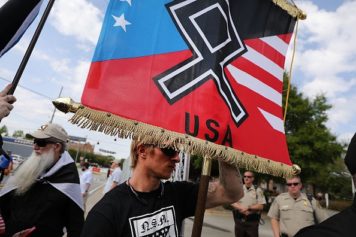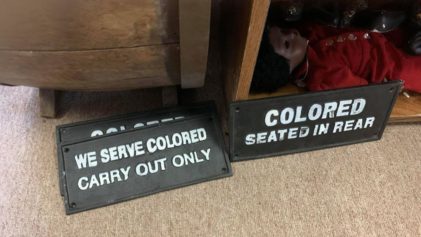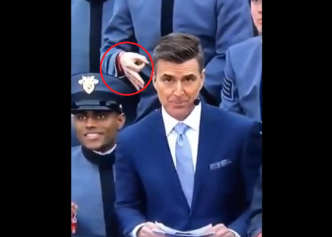
Anas Mohamed, 8, a third-grader at South Shore PK-8 School in Seattle, gets high-fives as he enters his school Monday morning. The school hosts more than 250 Black men Monday morning as they greet students as they walk into school.
In a sea of negativity concerning the stereotypes of Black men, it is clear that years of racially demeaning portrayals of Black people in popular culture and the media have done their damage.
Not only does the greater society employ these negative stereotypes to justify the continued oppression that we suffer, but our children internalize the negative stereotypes and believe them, for lack of any positive or life-affirming images of themselves. And so, people of all racial backgrounds become conditioned to believe these racial stereotypes are true.
Today, the media are purveyors of Black criminality — particularly Black male criminality — of the Black man as thug and gang-banger, drug dealer, high school dropout and other things. Malcolm X said it best when he spoke of the “irresponsible press” that “will make the criminal look like he’s the victim and make the victim look like he’s the criminal. If you aren’t careful, the newspapers will have you hating the people who are being oppressed and loving the people who are doing the oppressing.”
This is why it is so important to change the narrative of Black people. As was reported in the Seattle Times, more than 200 Black men came to greet children at Seattle’s South Shore PK-8 School. They came dressed in the appropriate attire of their professions — professors, police officers and lawmakers — as part of National African-American Parent Involvement Day. The goal is to dismiss the negative stereotypes of Black men by presenting students with live success stories.
“Everyone is interested in changing the narrative,” said Earl Parker, whose son attends South Shore. “America only sees us on the news, in sports or entertainment. They don’t see us as fathers, as professionals.”
The Black men formed a line, giving the children high-fives and greeting them with statements such as “Hello, future president.”
“Growing up, we never did something like this,” said Bryan Adamson, professor at the Seattle University School of Law. “I had great role models, but this would have made it better.”
“[Students] remember, and they model,” he added. “They see these images of what they could become, whether they look like us or not, and go into their communities. They are the ones changing the narrative.”
Meanwhile, during Black History Month, a collection of racist memorabilia with racist depictions of Black people is on exhibit at the Castle Museum of Saginaw County History in Saginaw, Michigan. The 39-piece traveling exhibit, called “Hateful Things,” is on loan from the Jim Crow Museum of Racist Memorabilia at Ferris State University, a small part of a 10,000-piece collection, as Mlive.com reported.
According to the Castle Museum, the exhibit “represents nearly 150 years of violence against African-Americans through objects and images that embody the terrible effects of the Jim Crow legacy.” The exhibit is designed not to sensationalize, but rather to open up a dialogue about race, race relations and racism, as it “seeks to use the artifacts of intolerance to teach tolerance and promote social justice.”
“During my years as a sociology professor, I learned that objects of intolerance — including ‘contemptible collectibles’ — could be used to teach tolerance and social justice,” said Dr. David Pilgrim, the exhibit’s creator and curator. “For me, this is not abstract musings. I have seen the value of these objects as teaching and learning tools; I have witnessed the productive, though often difficult, dialogues that were enhanced by the objects in the exhibition.”
According to Pilgrim, Jim Crow could not have thrived without violence and millions of caricatured items which buttressed that system.
We can see the effects of racial stereotypes through a number of recent studies. For example, a psychological study from the University of Iowa revealed that “perceived threat commonly associated with Black men may generalize even to young Black boys” as young as five. Subjects in the study, published in Psychological Science, more readily associated the images of guns with the faces of Black boys than the faces of white boys. Moreover, the participants were more apt to mistake a toy gun for a real gun after seeing an image of a Black boy.
In addition, research from two Arizona State University students found that white racial stereotypes of Blacks come from their perception of the environment in which Black people live, which is of a resource-poor and unpredictable (“desperate”) environment, as opposed to a resource-sufficient and predictable (“hopeful”) environment. In the study, stereotypes of Blacks were the same as stereotypes of people from desperate environments, while stereotypes of whites mirrored those of individuals from hopeful environments, as Phoenix Business Journal reported.
A study published in the Harvard Education Review examined the success stories of young Black men in college who excelled academically and were leaders in student government. As Inside Higher Ed reported, the Black students faced racism from faculty and students alike, who assumed they sold weed, plagiarized their work, or did not belong in college. The study found that their student leadership roles helped these young Black men speak up against stereotyping and racism they witnessed in the classroom and on campus, and confront those who make the racist statements. Further, their leadership roles resulted in less racial stereotyping from professors.
This comes as a study published in the journal Educational Theory shows that “grit” — the notion that students can persevere through adversity by toughing it out — serves only to make an emerging mental health crisis among Black college students who are struggling against racial stereotyping. The coping strategy is known as “John Henryism,” named after a folk hero who died of a heart attack after going up against a steam-powered hammer in a test of strength. The authors found that Black students are spending a great deal of time fighting racism, which is time they could be spending on academic achievement. This notion of grit would not be so much of an issue, the authors say, if these white institutions were not so racially hostile.
“We have witnessed Black students work themselves to the point of extreme illness in attempting to escape the constant threat of perceived intellectual inferiority,” said Ebony McGee, co-author of the study and assistant professor of diversity and urban schooling at Vanderbilt University, to Inside Higher Ed. “We argue that the current enthusiasm for teaching African-American students with psychological traits like grit ignores the significant injustice of societal racism and the toll it takes, even on those students who appear to be the toughest and most successful.”


